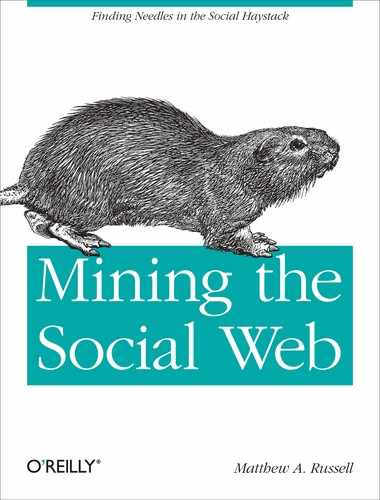While the previous chapters attempted to provide an overview of the social web and motivate you to get busy hacking on data, it seems appropriate to wrap up with a brief postscript on the semantic web. This short discussion makes no attempt to regurgitate the reams of interesting mailing list discussions, blog posts, and other sources of information that document the origin of the Web, how it has revolutionized just about everything in our lives in under two decades, and how the semantic web has always been a part of that vision. It does, however, aim to engage you in something akin to a cocktail discussion that, while glossing over a lot of the breadth and depth of these issues, hopefully excites you about the possibilities that lie ahead.
Let’s start out by dissecting the term “semantic web.” Given that the Web is all about sharing information and that a working definition of semantics is “enough meaning to result in an action,”[62] it’s not a very big leap to deduce that the semantic web is mostly about representing knowledge in a very meaningful way. But let’s take that one step further and not assume that it’s a human who is consuming the information that’s represented. Let’s consider the possibilities that could be realized if information were shared in a fully machine-understandable way—a way that is unambiguous enough that a reasonably sophisticated user agent like a web robot could extract, interpret, and use the information to make important decisions. Some steps have been made in this direction: for instance, we discussed how microformats already make this possible for certain domains in Chapter 2, and in Chapter 9 we looked at how Facebook is aggressively bootstrapping an explicit graph construct into the Web with its Open Graph protocol. But before we get too pie-in-the-sky, let’s back up for just a moment and reflect on how we got to where we are right now.
The Internet is just a network of networks,[63] and what’s very fascinating about it from a technical standpoint is how layers of increasingly higher-level protocols build on top of lower-level protocols to ultimately produce a fault-tolerant worldwide computing infrastructure. In our online activity, we rely on dozens of protocols every single day, without even thinking about it. However, there is one ubiquitous protocol that is hard not to think about explicitly from time to time: HTTP, the prefix of just about every URL that you type into your browser, the enabling protocol for the extensive universe of hypertext documents (HTML pages), and the links that glue them all together into what we know as the Web. But as you’ve known for a long time, the Web isn’t just about hypertext; it includes various embedded technologies such as JavaScript, Flash, and emerging HTML5 assets such as audio and video streams. All of that rich interaction makes the term “hypertext” sound a little antiquated, doesn’t it?
The notion of a cyberworld of documents, platforms, and applications that we can interact with via modern-day browsers (including ones on mobile or tablet devices) over HTTP is admittedly fuzzy, but it’s probably pretty close to what most people think of when they hear the term “the Web.” To a degree, the motivation behind the Web 2.0 thought process that emerged back in 2004 was to more precisely define the increasingly blurry notion of exactly what the Web was and what it was becoming. Along those lines, some folks think of the Web as it existed from its inception until the present era of highly interactive web applications and user collaboration as being Web 1.0, the current era of Rich Internet Applications (RIAs) and collaboration as the Web 2.x era, and the era of semantic karma that’s yet to come as Web 3.0 (see Table 10-1). At present, there’s no real consensus about what Web 3.0 really means, but most discussions of the subject generally include the phrase “semantic web” and the notion of information being consumed and acted upon by machines in ways that are not yet possible at web scale. For example, it’s still very difficult for machines to extract and make inferences about the facts contained in documents available online. Keyword searching and heuristics can certainly provide listings of very relevant search results, but human intelligence is still required to interpret and synthesize the information in the documents themselves. Whether Web 3.0 and the semantic web are really the same thing is open for debate; however, it’s generally accepted that the term semantic web refers to a web that’s much like the one we already know and love, but that has evolved to the point where machines can extract and act on the information contained in documents at a granular level.
Table 10-1. Various manifestations/eras of the Web and their virtues
| Manifestation/era | Virtues |
|---|---|
| Internet | Application protocols such as SMTP, FTP, BitTorrent, HTTP, etc. |
| Web 1.0 | Mostly static HTML pages and hyperlinks |
| Web 2.0 | Platforms, collaboration, rich user experiences |
| Social web (Web 2.x ???) | People and their virtual and real-world social connections and activities |
| Web 3.0 (the semantic web) | Prolific amounts of machine-understandable content |
[62] As defined in Programming the Semantic Web , by Toby Segaran, Jamie Taylor, and Colin Evans (O’Reilly).
[63] Inter-net literally implies “mutual or cooperating networks.”
